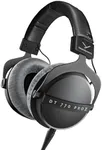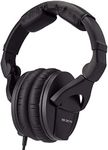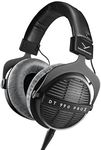Buying Guide for the Best Studio Headphones For Guitar
Choosing the right studio headphones for playing guitar is crucial for ensuring you get the best sound quality and comfort during your practice or recording sessions. The right pair of headphones can make a significant difference in how you perceive your playing and how you mix your recordings. Here are some key specifications to consider when selecting studio headphones for guitar, along with explanations to help you make an informed decision.Frequency ResponseFrequency response refers to the range of bass, midrange, and treble that the headphones can reproduce. This is important because it affects how accurately you hear the different elements of your guitar sound. A wider frequency response range (e.g., 20 Hz to 20 kHz) ensures that you can hear both the deep lows and the sparkling highs. For guitar, you want headphones that can handle the full spectrum of your instrument's sound, so look for headphones with a broad and flat frequency response.
ImpedanceImpedance is a measure of electrical resistance and is important because it affects how much power your headphones need to produce sound. Studio headphones typically have higher impedance (e.g., 250 ohms) which means they require more power and are best used with dedicated headphone amplifiers or audio interfaces. Lower impedance headphones (e.g., 32 ohms) can be used directly with devices like smartphones or laptops. If you plan to use your headphones with professional audio equipment, higher impedance models are preferable. For casual practice, lower impedance headphones might be more convenient.
Closed-Back vs. Open-BackClosed-back headphones have ear cups that are sealed, which helps to isolate sound and prevent it from leaking out. This is important for recording, as it prevents the sound from your headphones from being picked up by microphones. Open-back headphones have ear cups that are open, allowing air and sound to pass through. This design provides a more natural and spacious sound but offers less isolation. If you need to record in a quiet environment, closed-back headphones are the better choice. For mixing and casual listening, open-back headphones can provide a more enjoyable experience.
Comfort and FitComfort is crucial, especially if you plan to wear your headphones for extended periods. Look for headphones with adjustable headbands, cushioned ear pads, and a lightweight design. Over-ear headphones that fully cover your ears are generally more comfortable for long sessions compared to on-ear models. Consider your head size and shape, and if possible, try on different models to find the best fit. Comfortable headphones will help you focus on your playing without distractions.
DurabilityDurability refers to how well the headphones can withstand regular use and potential wear and tear. This is important because you want your investment to last. Look for headphones made with high-quality materials, such as metal-reinforced headbands and sturdy ear cups. Detachable cables can also add to the longevity of your headphones, as they can be easily replaced if damaged. If you travel frequently or use your headphones in different environments, prioritize models known for their durability.
Sound IsolationSound isolation is the ability of the headphones to block out external noise. This is important for focusing on your playing and for accurate monitoring during recording sessions. Closed-back headphones generally offer better sound isolation compared to open-back models. If you often practice or record in noisy environments, prioritize headphones with good sound isolation. This will help you hear your guitar clearly without being distracted by outside sounds.
















